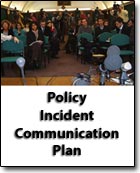Best Practices for Mass Notification Systems
Best Practices for Mass Notification Systems - New advancements, like sophisticated mass notification systems, provide organizations with a means to communicate with employees, partners, and customers during operational interruptions due to natural disasters. In an effort to leverage this technology and minimize the impact of disasters in the workplace, the CIO should examine business continuity and disaster recovery plans:
- Understand business continuity and disaster recovery needs. In the wake of an emergency, it's imperative to maintain clear and effective channels of communication in order to quickly assess damages and coordinate recovery efforts. Because essential business operations can be affected by any stage of interruption, companies should be prepared with an important message delivery system, such as automated notification, to communicate with employees and first responders.
- Choose notification systems that offer a range of choices. When selecting a notification system, research its capabilities and consider systems that allow two-way communication over a variety of channels, including land line, fax, mobile, Short Message Service (SMS), Blackberry PIN-to-PIN, email, and more. These advanced features become very useful in the delivery of important and urgent information when communication infrastructure is compromised, a common issue when metropolitan areas are affected by quickly spreading wildfires.
- Ensure contact data is up-to-date. Companies should regularly check their recipient lists to ensure that all contact information is up-to-date so when a disaster occurs, employers are confident that notifications are being delivered to the right person on the correct device.
- Create escalation plans. Crisis situations demand that the proper people are contacted about a situation that needs immediate attention. Intelligent notification systems include integrated mechanisms that support a call escalation process. If the first person contacted is not the correct individual for the situation, the notification system automatically contacts the next appropriate person according to pre-determined processes
- Train personnel and test systems. When creating business continuity and disaster recovery plans, it is essential to properly train personnel on how to use notification systems so they are able to monitor the entire alert process. Studies show that companies who educate their employees correctly achieve significantly greater response rates. Also, be sure to test alert systems during normal business hours and address any glitches to be certain notification deliveries are successful when needed. As a guideline, at least two system tests per year are recommended.
- Incentivize all employees to sign-up for notifications. When a notification system is installed, it is critical that all user contact information is saved within the system's database so that staff can be alerted immediately during an urgent situation. Various incentive methods may be used - such as drawings, prizes, and awards - to persuade all required personnel to register. This ensures the reliable and speedy delivery of important messages at the right time, to the right person, on the right device.
- Establish reactive steps to follow after the disaster. When proactive measures fail, business continuity management programs must specify reactive procedures. This will help organizations to return to normal operations as quickly as possible and will help them better prepare for future crises such as wildfires.
All of these steps are defined with the Janco's "Disaster Recovery - Business Continuity Template".
Incident Communication Plan Policy
 Now Includes Social Networking as a Media Outlet
Now Includes Social Networking as a Media Outlet
Compliant with ISO/IEC 27035:2011
NEW Electronic Forms - Incident Communication Contact Form
and Pandemic Planning Checklist
Order Incident Communication Policy Download Selected Pages
To survive an incident such as a business interruption, security breach, or a product recall, organizations need more than a successful communication strategy - they need an incident communication plan.
The overall objectives of a incident communications plan should be established at the outset. The objectives should be agreed upon, well understood, and publicized. For example, will the primary objective of the communications plan be for communications only to employees, and only during a disaster? Or is the intent to advise customers of interruptions to service? Or is it for investors and stockholders? Or regulatory agencies? Or is it some combination of these?
Whatever the objectives of the enterprise, they should be shared, supported by executive management, and widely communicated - both via traditional media contact and social networks. This policy template addresses those needs directly as well as provides electronic tools that aid in the execution of of the policy.
The specific objective of this incident communication plan is to define who will provide key communications during a crisis including content, recipients, schedule, method of delivery, frequency, and priority of the communication. By outlining a communication plan in advance, the business is better able to
- Communicate the effects and status of a crisis for employees, associates, suppliers and customers,
- Reduce the impact of bad publicity, maintain customer service, bolster relations with vendors and
- Address the concerns of other key stakeholders
Order Incident Communication Policy Download Selected Pages





